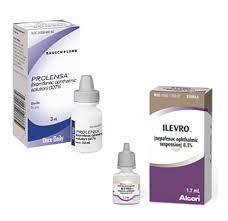Prevent Cataract Post-operative inflammation
Nonsteroidal anti-inflammatory drugs (NSAIDs) given as eye drops appear to work as well alone as they do in combination with steroids to prevent swelling of the macula after cataract surgery, researchers say.
The anti-inflammatory eye drops work just as well whether administered before or after surgery and are more effective than a sub-Tenon implant that elutes steroids, said Jesper Erichsen, MD, Ph.D., a researcher at Rigshospitalet Glostrup in Denmark.
“Maybe it would be preferable to have NSAID eye drops as the standard approach, and then you could add steroid eye drops if they are needed,”
Pseudophakic cystoid macular edema, a common complication of cataract surgery, can affect visual acuity. Researchers believe that it results from inflammation that disrupts the blood–ocular barrier and leads to the leakage of fluid into the retina.
To prevent it, surgeons prescribe anti-inflammatories, but there is no consensus on which ones to use, said Erichsen. “It would be a nice thing if there was a standard of care. But it seems to me that this differs quite a lot. “
Steroid eye drops have a long track record for this purpose and are considered more potent than NSAIDs, but they have been associated with increased intraocular pressure (IOP).
Because some patients have trouble administering eye drops, various slow-release depots and injections have been developed.
And some research has suggested that starting the prophylaxis before surgery is more effective.
To put various approaches to test, Erichsen and colleagues recruited 470 patients at Rigshospitalet Glostrup who were undergoing cataract surgery. They randomly assigned 94 patients to each of the five groups.
In the preoperative combination group — which served as the control group — the steroid and NSAID combination eye drops were started 3 days before surgery. In the postop combination group, the steroid and NSAID combination eye drops were started the day of surgery.
In the preop NSAID group, NSAID monotherapy was initiated 3 days before surgery. In the postop NSAID group, NSAID monotherapy was initiated on the day of surgery.
In the subtenon group, a subtenon depot of dexamethasone phosphate 0.5 mL was administered after surgery.
All eye drops were administered 3 times per day until 3 weeks after surgery. As the NSAID, the researchers used a ketorolac 0.5% solution. As the steroid, they used a prednisolone 1% solution.
At follow-up — 3 days after the surgery, 3 weeks after surgery, and 3 months after surgery — the researchers found no difference in mean central subfield thickness (CST) or corrected distance visual acuity (CDVA) between the preop NSAID group and the groups that received preop or postop combination eye drops.
IOP decreased in all groups. After 3 days and 3 weeks, IOP was higher in both combination groups than in both NSAID monotherapy groups, but that difference had faded by 3 months.
More than half the subtenon group needed additional topical anti-inflammatory drops, suggesting that this approach is not sufficient, Erichsen said.
“This is an important study to further help optimize the postoperative regimen for cataract surgery,” said Francis Mah, MD, co-director of refractive surgery at Scripps Clinic in La Jolla, California.
“It adds more support toward not needing steroids, especially in this modern-day and age where we’re doing modern-day sophisticated cataract surgery, generating a lot less inflammation, ” he told Medscape Medical News.
Mah said he would have liked to see data on the outcomes as early as the first day after surgery.
Subtenon depots are not the best approach to dropless anti-inflammatory prophylaxis because they can cause red spots and discomfort, he explained. An intracanalicular dexamethasone insert and an intraocular dexamethasone injection are both less invasive, but there are challenges to reimbursement for these treatments in the United States, he noted.
see more:
Diet based prevention of hypertension and preeclampsia



